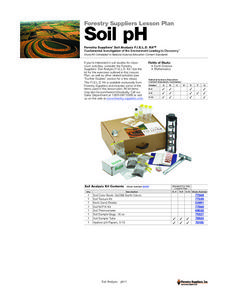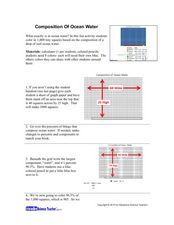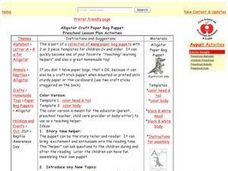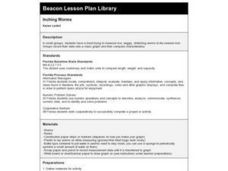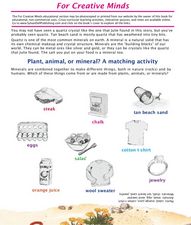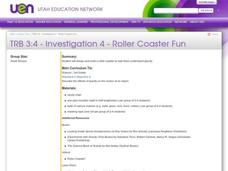Curated OER
Let's Think About... Magnets and Gravity
Students watch an episode of the PBS show "Jay Jay the Jet Plane," and explore magnets and gravity. They conduct various experiments involving magnets and sand, bean bags, and a fishing pole with magnets.
Curated OER
Radioactive Decay
Students explore radioactive decay. Through various activities, students examine methods for permanent disposal of radioactive waste. After performing a random process experiment, students compare the results to radioactive decay. ...
Curated OER
Acid Rain And How It Affects Our Environment
Young scholars explore acid rain. In this science lesson plan, students demonstrate phenomenologically the effects of acid rain on our environment and perform long-term "real-time" experiments.
Curated OER
Changing Matter
Fifth graders conduct an experiment. In this changing matter lesson plan, 5th graders receive a cup of crystals, record their observations, add water to the crystals and record new observations. Students then discuss the...
Curated OER
Does salt have an effect on the temperature of ice?
Students explore the effect that salt has on the temperature of ice. In this scientific inquiry lesson, students observe an experiment to see how cold ice can get when salt is added. Students then explore how the ice compares to...
Curated OER
Ziplock Chemistry
Pupils participate in an experiment in which the substances are sealed in a plastic bag. Watching the experiment, they determine why the chemical reaction is taking place and calculate the temperature change. To end the lesson, they...
Curated OER
Microscope Investigation
Pupils explore physical science by participating in a science examination. In this microscope tutorial instructional activity, students read the book The Naked Eye and discuss the purpose for using a microscope in the field of science....
Curated OER
Forestry Suppliers
Students explore the scientific reasons that certain types of foods cause different reactions when they interact with the tongue. They analyze the differences between acids and basics. The experiment is performed at three different sites...
Curated OER
The Magic School Bus Goes on Air
Students conduct an experiment to determine the properties of air based on a Magic School Bus adventure. They inflate and deflate zipper plastic bags to show that air takes up space and holds objects. They associate this with riding a...
Curated OER
Sunlight and Warm Air
Students discuss radiant energy from the sun, performing a simple experiment with sun glasses and bright light to demonstrate the concept. Students further participate in simple in-class experiments to demonstrate: air density as it...
Curated OER
Composition of Ocean Water
Learners experiment to determine the composition of ocean water. In this ocean water composition lesson, students color in a grid that shows the percentage of each of the components of ocean water which include chloride, sodium, sulfate,...
Curated OER
Swords, Arrows, and Eggs
Students enjoy hands-on learning experiences. In this current events lesson, students may visit the Lulworth Castle, Roald Dahl Museum, Glasgow Science Centre, Salts Mill, or the Sherwood Forest online or in-person to discover details of...
Curated OER
Mystery Paint
Students use the scientific method to determine the properties of various kinds of paints, use collected data to identify paint samples that are not properly labeled and use proper science safety techniques while working with chemical...
Curated OER
Alligator Craft Paper Bag Puppet
Students make paper bag puppets. They use the puppets as a story teller and reader. Students use the puppets to ask questions during and after reading. They assemble their own puppet. Students use the puppets to introduce new themes,...
Curated OER
Color Splash
Learners investigate density. In this density lesson, students conduct an experiment using food coloring. Learners observe the differences in mixing food coloring in water and oil.
Curated OER
Inching Worms
Third graders have a blast trying to measure live, wiggly, stretching worms to the nearest inch. Groups record their data onto a class graph and then compare characteristics. They share their findings with the rest of the class. Fun lesson!
Curated OER
Building a DNA Molecule, Mitosis in Motion and Mutation Gossip
Students explore three lab experiments involving DNA, mitosis, and mutation. They complete activities and play games to review DNA, mitosis and mutation concepts. They build a DNA molecule and create flip cards representing mitosis in...
Curated OER
Brain and Senses
Students investigate the brain through multiple senses. In this biology lesson, students experiment with different activities involving taste, memory, touch, and sight to understand how the brain works. Students work in partners and...
Curated OER
For Creative Minds
Students study pictures of plants, animals, and minerals. Students classify the pictures into the three groups. In this rock identification lesson, students complete a rock finding lab experiment by finding, cleaning, identifying, and...
Curated OER
Roller Coaster Fun
Third graders review the effects of gravity on how objects move. In groups, they design a roller coaster and share it with their classmates. Using materials given to them, they build their roller coaster and let a ball roll on the...
Curated OER
A Dinosaur Scavenger Hunt
Students explain what a fossil is, learn six dinosaurs and tell one characteristic about each, then describe verbally what a dinosaur might have looked like.
Curated OER
Baking Soda and Vinegar Volcano
Students construct a volcano using baking soda and vinegar. In this earth science instructional activity, students explain the reaction that takes place when these two chemicals combine together.
Curated OER
Science: The Age of the Redwoods
Students discover how to estimate the age of redwood trees. They measure the trees' diameters by using string to calculate the circumferences. Students conclude by discussing the science of dendrochronolgy.
Curated OER
Fun with Ecology
Students explore their environment. Given a question and a scenario, they conduct a field study of a designated area. In that area, they count and tally the number of insects that are present.







